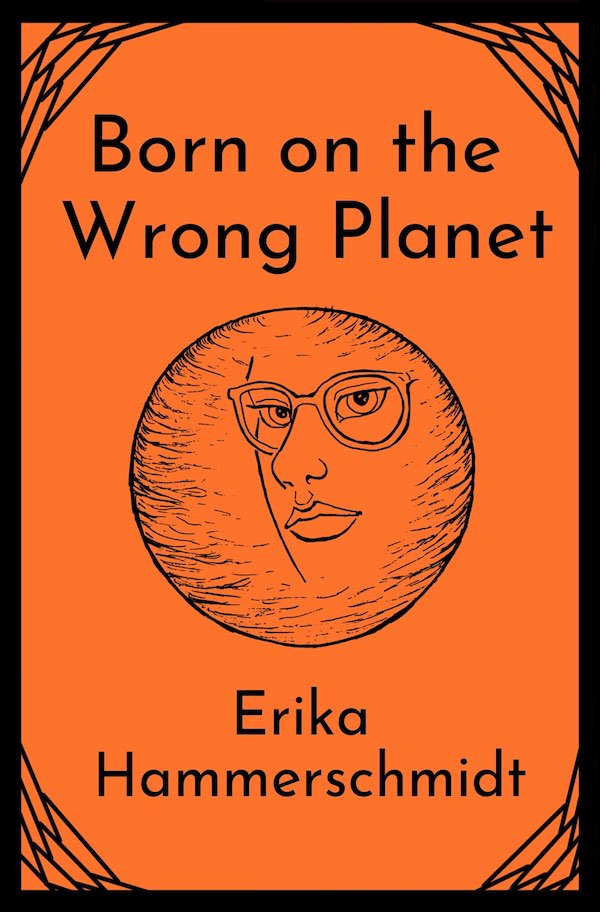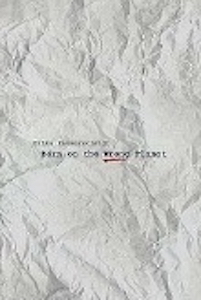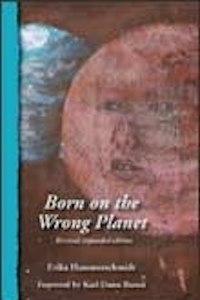Born on the Wrong Planet


 -
- 

BUY:
Amazon - Lulu ebook - Lulu print - Smashwords - B&N
Born on the Wrong Planet
My first published book, and the story of my life up to young adulthood.
It was published by Tyborne Hill Publishers while I was in college, in 2003, and republished by Autism Asperger Publishing Company in 2008. The book is about my childhood with Asperger's Syndrome and various other diagnoses.
Born on the Wrong Planet is now self-published online! The book went out of print from AAPC and has reverted to me to be republished. I will update this page as time goes on. Places where it is currently available to buy:

For more information about the editions of the book, keep reading:
What editions of Born on the Wrong Planet are there?
My first publisher, Tyborne Hill, printed two editions, one shortly after the other. They are almost identical. Both have the cover shown on the left, above, with the crinkled paper pattern. If you have a copy with the crinkled-paper cover, and it contains a chapter called "Having a Reason," it is Tyborne Hill's second edition. If it does not contain that chapter, it is Tyborne Hill's first edition. The first was published in 2003, the second very soon afterwards.
My new publisher, AAPC, printed a new edition from 2008 to 2016. It contained all but one of the chapters that were there before, plus several new chapters about things that have happened since the first publication, like my marriage and my semesters abroad. It had the cover with the two planets and the blue edge, which was made from one of my paintings. We called it a second edition, because we agreed that the two editions printed by Tyborne Hill were too similar to each other to be called different editions.
Now that it is out of print from AAPC, I have created a new Third Edition, the one with the orange cover. I've altered and removed very little, but added some new chapters. That edition is what I now have for sale in print and ebook forms, on Amazon, Lulu, Smashwords and Barnes&Noble.
Why are some chapters written in third person, referring to yourself as "she" instead of "I"?
I don't know. That's the way they came into my head when I got the idea of writing them. I guess it's an attempt to show my childhood from other people's perspectives as well as my own. In particular, a few chapters are told from my mother's perspective, because I actually have no memory of the events in them, and I reconstructed them for the book from conversations I had with my mom.
Who are "Polly" and "Ricki" in the chapter "Having a Reason"?
In the Tyborne Hill edition, I referred to myself as "Ricki" and my mother as "Polly" in that chapter. Since I was telling the story in third person, it felt strange to use our own names, for some reason. In the first draft, I told the story without names, simply saying "the mother" and "the child." But my publisher insisted I use names, and I chose Polly and Ricki because they are sometimes used as nicknames for Mary and Erika (my mother's name and my name). I realize now that it is very confusing, and in the AAPC edition I have changed the names to Mary and Erika... which I hope will clear things up.
What's the deal with the chapter "In a Future Life"?
That chapter is one that I feel doesn't really fit in the book. In fact, it has been removed in the new edition. Basically, it's a remnant from what this book was in its very first incarnation.
When I submitted my manuscript to the first publisher, it was not an autobiography at all. It was a 300-page collection of fictional short stories, nonfictional essays, and poems, all of which had very little in common. The publisher saw something in it that he liked, and he accepted it, saying that he wanted me to change "a few things." Then, after I had signed the contract, he told me that he actually wanted me to rewrite the book completely, removing nearly all of what was in it, and expanding on the few topics he found worthy.
This resulted in a good, sellable book, but the publisher also made several choices that I didn't quite understand... including the choice to leave one completely fictional story in a book that was otherwise an autobiography.
The story isn't about me. It's about a character that is very loosely based on some aspects of my personality. I wrote it for a creative writing class in my freshman year of college, when I had so much spare time on my hands that I sometimes started asking myself random questions like "what if the song I just heard on the radio was written about someone who was me in another life?" It has only a tangential connection to the rest of the book, and understanding the plot requires a lot of analysis.
The scenes in the story alternate between one time period and another. The plot of the story is basically that one character (Melanie) can see the future and knows that she is going to be reincarnated as another character (Desiree). Melanie has several friends; Desiree has almost none.
During the scenes in which Melanie is with her friends, she appears to become secretly fed up with their company (especially that of her friend Lena, who has very poor grammar but thinks she has very good grammar.) In the end, Melanie gets another glimpse into the future, realizing that she is going to die from eating a poisoned fortune cookie. She eats it anyway, apparently driven over the edge by Lena's inaccurate attempts to correct her grammar. She dies, and a poet is at her funeral (getting the inspiration to write something that later becomes the favorite poem of Desiree, who does not know that she is Melanie's reincarnation).
The implication of the story is that Melanie got so sick of her friends that she preferred the life she expected to have as the friendless Desiree. It is a very different kind of story, I know, and does not belong in the book. It is not in the AAPC edition.
Any more questions? Contact me at human alien at gmail dot com.


!!! Latest News !!!









